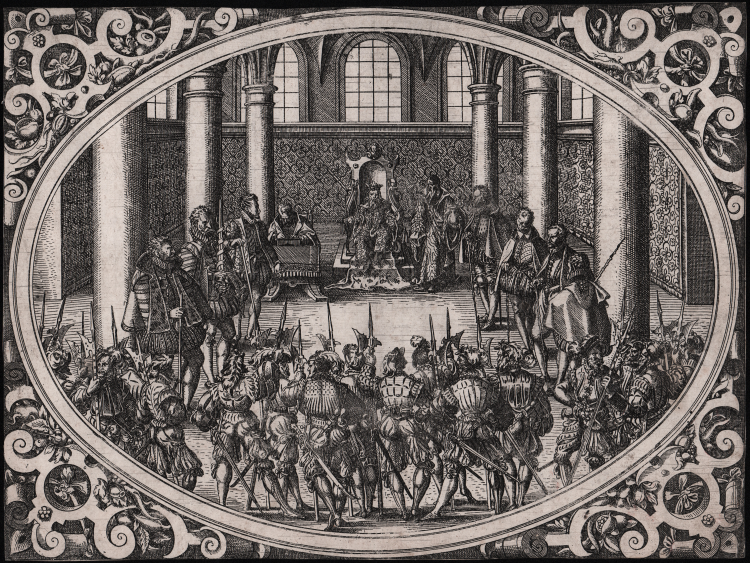



| Reference: | S42006 |
| Author | Jost AMMAN |
| Year: | 1579 |
| Measures: | 357 x 268 mm |


| Reference: | S42006 |
| Author | Jost AMMAN |
| Year: | 1579 |
| Measures: | 357 x 268 mm |
Etching on iron, 1579, unlettered. First state, of two, before the numbering 6 added lower right in the plate.
The plate depicts a king sitting on a throne holding a sceptre in centre background, on the left a scribe, on either side of the room the king's advisors, soldiers standing in the foreground. Set in an oval frame, the corners filled with strapwork ornaments.
A fine impression, printed on contemporary laid paper, trimmed to the paltemark, very good condition.
Printed in Catalogus Gloriae Mundi by Barthélemy de Chasseneuz, printed in 1579, Frankfurt - Sigmund Feyerabend.
Barthélemy de Chasseneuz (1480–1541) was a lawyer, and he was neither a narrow-minded one nor a bad one – quite the opposite. He had attended French and Italian universities and had been the student of some of the most famous teachers of his time. The talented legal scholar had acquired experience at the court of the duke of Milan and even at the court of the Pope himself. And yet, he returned to his home country in 1506 where he took up high offices.
As his contemporaries, Barthélemy de Chasseneuz was convinced that everything on earth had a precise order. He believed that any kind of dispute arose solely from the fact that humankind was unaware of the exact structure of this order. It was obvious that the King of France was of higher status than a juggler. But what about the King of France and the King of Aragon? Who of them was of higher status?
Being a good lawyer, Chasseneuz sat down and studied the sources. He wrote more than 1,000 pages setting out which office held which rank based on all theological, philosophical and legal sources available to him – from the hierarchy of the Heavens to the social ranks of humankind and to animate and inanimate nature. In 1529, this book was published for the first time.
Chasseneuz’ book was of huge importance to all those who had to deal with issues of ceremonial protocol. All princes and city councillors had enough money to afford an expensive book. That’s why, at some point during the 70s of the 16th century, Sigmund Feyerabend from Frankfurt decided to publish a new edition of Chasseneuz’ work.
He did not simply reprint the first edition, instead, he hired the famous book illustrator Jost Amman to transform Barthélemy de Chasseneuz’ theoretical considerations into impressive – and easily understandable – copper engravings.
Bibliografia
The New Hollstein, Part VI.87.144.23.i, p. 87.
Jost AMMAN (Zurigo 1539 – Norimberga, 17 Marzo 1591)
|
Swiss draughtsman, woodcutter, engraver, etcher and painter. He was the youngest son of the noted scholar and Chorherr in Zurich, Johann Jakob Amman, a friend of Ulrich Zwingli and Konrad Gessner. Although a successful pupil at the renowned Collegium Carolinum where his father was a professor, Jost, like his brother Josua (1531–64), who became a goldsmith, did not take up a scholarly career. As early as 1556–7 his copies of prints by other artists, for example Dürer and Virgil Solis, show an independent and original approach. For his apprenticeship Amman may have been in Basle or Zurich, but he probably spent some time in Paris or Lyon, since his early works show a close similarity to French book illustrations.
|
Jost AMMAN (Zurigo 1539 – Norimberga, 17 Marzo 1591)
|
Swiss draughtsman, woodcutter, engraver, etcher and painter. He was the youngest son of the noted scholar and Chorherr in Zurich, Johann Jakob Amman, a friend of Ulrich Zwingli and Konrad Gessner. Although a successful pupil at the renowned Collegium Carolinum where his father was a professor, Jost, like his brother Josua (1531–64), who became a goldsmith, did not take up a scholarly career. As early as 1556–7 his copies of prints by other artists, for example Dürer and Virgil Solis, show an independent and original approach. For his apprenticeship Amman may have been in Basle or Zurich, but he probably spent some time in Paris or Lyon, since his early works show a close similarity to French book illustrations.
|